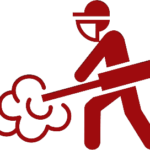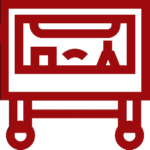Residential & Commercial Services

Cleaning (Manual)
To many, cleaning is a lot more complicated than we understand it to be. There are various methods used to clean surfaces, found both in residential and commercial areas. Here at D&N Hygienics, it is of utmost importance that our customers gain an in-depth understanding behind the strategies implemented with our cleaning services. It important for our customers to note that cleaning primarily aims to remove germs and other organic material and does not actually kill them.
- Sweeping: We start off with a clean sweep of the different areas in the location to collect all the dust, this is performed with a broom and a dustpan.
- Dusting: In this step of the cleaning phase surfaces are wiped and dusted. Cleaning (Mechanical)
- Vacuum: Using a vacuum would replace the manual process of sweeping.
- Floor cleaning machine: We use floor cleaning machines to eliminate oil, floor marks, grease, and more. We offer this as a more hygienic alternative to using a vacuum or sweeping.

Sanitizing
Understanding the true impact of sanitizing may also catch the general public off-guard. Contrary to popular belief, sanitizing, even though more effective than cleaning, does not kill all germs. Instead sanitizing lowers the number germs to a safe level by removing most of them (as stated by public health measures). It is important to note that most surfaces must have been cleaned prior to sanitization to ensure the highest level of effectiveness.
- For a product to be considered a sanitizer it must kill at least 99.9% of germs found on surfaces.
- Sanitizers only work on solid, non-penetrable surfaces.
- Sanitizers are only temporary, as soon as surfaces have been used or subjected to contact germs will begin to grow on the surfaces again.
- What we usually sanitize: utensils, dishes, cups, surfaces used to prepare food, tables, chairs, countertops, and surfaces that are often used.

Disinfecting
Disinfecting works similar to sanitizing with an extra kick in it. Disinfecting, much like sanitizing, uses chemicals to deal with germs. However, disinfecting actually kills harmful germs rather than just lowering the number of germs to a safe level. This indeed is more effective than sanitizing and is the safest option to eradicate germs. Like sanitizing, it is important to note that most surface must have been cleaned prior to disinfecting to ensure the highest level of effectiveness.
- For a product to be considered a disinfectant, it must kill at least 99.999% of germs found on surfaces.
- Disinfectants kill germs on contact when they are used on surfaces for a certain amount of time.
- Disinfectants only work on solid, non-penetrable surfaces.
- Disinfectants are only temporary, as soon as surfaces have been used or subjected to contact germs will begin to grow on the surfaces again.
- What we usually disinfect: door & cabinet handles, sinks & faucets, floors, toilets, and countertops.

Sterilizing
Sterilization is placed in a field separate from cleaning, sanitizing, and disinfecting. Sterilizing is not often used in average households and businesses, but rather in specific industries only. Unlike sanitizing and disinfecting, sterilizing areas will not only lower and eliminate existing germs; sterilizing areas will kill all life forms of microbes.
- Sterilization is usually used in hospitals, healthcare facilities, dental offices, pharmacies, laboratories, operating rooms, and nail salons.
- What we use to sterilize: autoclave (most common piece of equipment used for sterilization)
